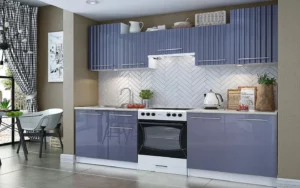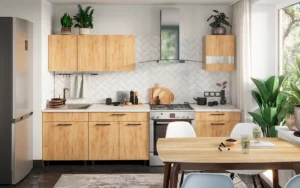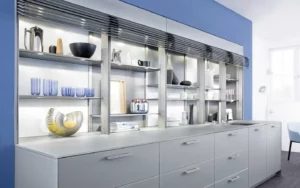Cabinets serve as a cornerstone in shaping a home’s aesthetic and functional potential. Framed and frameless cabinets emerge as two notable contenders among the broad spectrum of choices at the disposal of homeowners and designers. Although these styles fulfill identical primary objectives, they present differences in construction, visual charm, and operational aspects.
Read more about kitchen cabinet types
Delving into Cabinet Construction
Framed cabinets, often American-style, feature a wooden border enclosing the box’s front outer edge. This structure imparts added strength and sturdiness, accommodating larger doors and drawers. Framed cabinets’ doors attach directly to the frame, enhancing their resilience against heavy-duty use.
Conversely, frameless cabinets, a common aspect of European design, disregard the need for a front frame. The cabinet doors are fixed directly to the cabinet box sides, providing a seamless visual experience. Frameless cabinets frequently feature full-overlay doors to optimize storage capacity, which proves advantageous in space-restricted kitchens.
Visual Divergences of Framed and Frameless Cabinets
Each style of cabinetry produces a unique visual impact. Framed cabinets often convey a traditional, classic impression owing to their intricate construction. They can support a range of door styles, encompassing inset, standard overlay, and full overlay, providing abundant design flexibility. Framed cabinets can incorporate visible hinges for a rustic vibe or concealed ones for a neater aesthetic.
In contrast, frameless cabinets provide a sleek, ultra-modern appeal. Their seamless contours and smooth surfaces blend effortlessly with contemporary and minimalist decor styles. The absence of a visible frame brings attention to the cabinet doors and drawer fronts, underscoring the material, color, and hardware.

Operational Elements
Framed and frameless cabinets each boast a unique set of functional benefits. Framed cabinets’ robust structure ensures their strength and longevity. The added frame offers support, enabling these cabinets to bear more weight. This attribute makes them apt for homes requiring cabinets to support heavier items.
Frameless cabinets, in comparison, provide more accessible storage space. Users can utilize the entire cabinet breadth since no center stile or face frame impedes access. Large cookware and other voluminous items can be stored and retrieved more easily in a frameless cabinet.
Mounting and Personalization
The installation processes for framed and frameless cabinets vary. Due to their sturdy structure, Framed cabinets can accommodate minor alterations during installation. However, installing frameless cabinets necessitates precision, as any uneven lines or gaps cannot be concealed.
Regarding customization, framed cabinets generally present a broader array of possibilities. They can be modified to align with different design tastes, from classic to contemporary, while frameless cabinets are typically more suited to modern design sensibilities.
Explore More The best kitchen cabinets in Bay Area
Material Factors in Framed and Frameless Cabinets
Concerning materials, both framed and frameless cabinets can be crafted from various woods and finishes. However, given their structure, framed cabinets may necessitate thicker and more robust material for the face frame, potentially influencing the overall cost. Conversely, due to their design, frameless cabinets can be constructed using thinner materials, offering some homeowners a cost-effective solution.
framed and frameless cabinets’ Hardware Choices
The choice of hardware can significantly modify the appearance and functionality of both types of cabinets. Framed cabinets can be designed with visible or concealed hinges, while frameless cabinets usually employ hidden hinges for their clean look. Different pulls, knobs, and handles can be chosen to enhance the overall design aesthetic, whether it leans toward traditional or contemporary.

framed and frameless cabinets’ Cost Consideration
The pricing of framed and frameless cabinets can greatly fluctuate depending on elements like materials, customization, and installation expenses. Due to their intricate installation process, frameless cabinets might command a slightly higher price. Nonetheless, the homeowner’s specific design preferences and choice of materials largely dictate the final expenditure.
Read more about low-cost cabinets
Which Type Of Cabinet Last Longer?
Owing to their robust build, framed cabinets can endure extensive use, rendering them a resilient option for active households. Alternatively, frameless cabinets may necessitate slightly more upkeep to preserve their seamless aesthetics but can exhibit equal longevity with proper care. The selection of finish can further impact the lifespan of both cabinet types.
Environmental Implications
As an increasing number of homeowners embrace eco-consciousness, contemplating the environmental impact of cabinetry becomes relevant. Framed and frameless cabinets can both utilize sustainable materials. However, the manufacturing process for frameless cabinets may be more energy-efficient due to the reduced waste stemming from their simpler design.
Cabinetry Trends
Cabinetry trends shift over time, influencing the preference for framed and frameless cabinets. While framed cabinets’ traditional charm is enduring, frameless, sleek, modern aesthetics resonate with current design inclinations. Nevertheless, the ultimate decision should prioritize personal taste over fleeting trends.
Space Factors
The space available within a kitchen can significantly sway the selection between framed and frameless cabinets. Frameless cabinets are an ideal choice for compact kitchens owing to their spatial efficiency, while framed cabinets can be a desirable selection for larger kitchens requiring design versatility.
Cabinetry’s Effect on Home Value
Lastly, the type of cabinetry can influence a home’s value. High-quality, well-maintained cabinetry, framed or frameless, can enhance a home’s resale value. Potential purchasers might appreciate framed cabinets’ classic aesthetics or frameless cabinets or the modern allure of frameless cabinets, contingent on their personal preferences. Therefore, it’s crucial to consider potential future resale value when deciding on cabinetry.

Customization and Versatility
In terms of customization, both cabinet types present unique benefits. Framed cabinets provide a variety of door styles and can cater to diverse design tastes, from traditional to transitional. Conversely, frameless cabinets offer significant versatility, especially in smaller or irregularly shaped kitchens where maximizing storage space is essential.
Learn more about semi-custom kitchen cabinets
Impact on Kitchen Operations
The choice between framed and frameless cabinets can also affect kitchen operations. Frameless cabinets, with their straightforward access and efficient storage, can streamline kitchen tasks, enabling smoother functionality. While framed cabinets may offer slightly less immediate accessibility, they present a sturdy and dependable storage solution that meets a bustling kitchen’s demands.
Cabinet Accessibility and Universal Design
Cabinet design can significantly contribute to establishing an inclusive kitchen environment. For those with mobility issues or those utilizing assistive devices, frameless cabinets, with their broader, unhindered access, may provide a more accessible solution. Nonetheless, the robustness and dependability of framed cabinets should be considered, especially when outfitted with assistive hardware solutions such as pull-out shelves or lazy susans.
Technology Incorporation in Cabinetry
In the age of smart homes, technology integration extends to cabinetry. Both framed and frameless cabinets can accommodate contemporary upgrades like integrated lighting, touch-latch opening, or even smart storage solutions optimizing space utilization. Depending on the desired level of technology, these upgrades could influence homeowners towards one style over the other.
Safety Considerations in selecting kitchen cabinets
The safety aspects of framed and frameless cabinets are often overlooked but equally important when deciding. Framed cabinets, with their sturdy construction, often offer more stability, which can be crucial in households with young children or pets. The strength of the face frame ensures that the cabinet doors and drawers remain secure, reducing the risk of accidents.
In contrast, due to their construction, frameless cabinets can be equipped with safety features like soft-close hinges and drawers. These features prevent the sudden slamming of cabinet doors and drawers, reducing the risk of trapped fingers and loud noises. Moreover, with frameless cabinets, the lack of a face frame reduces the likelihood of sharp edges, providing an added level of safety.

Future-Proofing Your Cabinetry
Making the right choice for cabinetry involves the foresight of its enduring value. As our needs evolve and design trends fluctuate, the merit of cabinets is in their ability to stand strong, both in terms of functionality and aesthetic appeal, throughout these changes.
The timeless charm of framed cabinets lies in their traditional aesthetics and sturdy construction. Their ability to adapt to various door styles makes them a versatile choice. These qualities allow them to seamlessly blend with various evolving design trends, underscoring their enduring relevance.
Conversely, frameless cabinets epitomize a sleek, modern design ethos that aligns harmoniously with contemporary and forward-thinking design trends. They are characterized by their efficient space utilization and the capability to incorporate the latest kitchen technologies. These features augment their enduring appeal in the world of cabinetry.
To Wrap Up
The choice between framed and frameless cabinets largely depends on personal aesthetic preferences, functional needs, and the specifics of a kitchen’s layout and design. Framed cabinets have a robust build and a classic charm, while frameless cabinets offer a modern aesthetic and optimized storage space. Understanding these distinctions can empower homeowners to make informed decisions that match their living space and lifestyle.
KEYWORDS:
